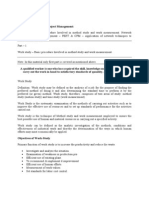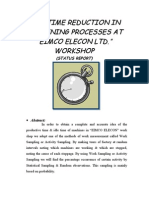Work Study Notes
Uploaded by
Succeed T MurwisiWork Study Notes
Uploaded by
Succeed T MurwisiWork Study
It is a generic term for a series of analytical techniques used to determine the most
efficient use of labor in relation to other inputs in the production process.
It was developed from the work of Fredrick Taylor (scientific management).
Aims of Work Study
To improve employee’s performance.
To increase efficiency, productivity and profitability.
To improve planning by provision of targeted time and procedures.
To provide the basis of incentives pay schemes such as piece rate.
To improve the flow of work.
To improve utilization of equipment, material and space.
Aspects of Work Study
There are two main aspects of work-study, which are:
1. Method / motion study.
2. Time study/Work measurement.
1. Method / Motion study
It is a systematic process of recording and evaluating the ways of doing work (for both
existing and proposed ones) as a way of developing easier and more efficient methods
thereby reducing costs.
OR a detailed evaluation of the way in which a task is carried out .
FW Taylor advocated that workers should use minimum energy in doing a job and so tire
less quickly. This opened way for the mechanisation and re organisation of the
workstations.
Objectives
* improve quality
* improve procedures and processes ( make the job easier)
* improve the design and layout at of the workplace
* improved utilisation of manpower, equipment and materials.
* Improve health and safety at the workplace (make the job safer)
* improve labour productivity and reduce fatigue and injury.
Advantages of Method Study
It increases organizational efficiency.
It enables the organization to increase the level of profits.
It can be used in reduction of costs.
Disadvantages of Method Study
It is time-consuming and laborious.
It is expensive.
2. Time study/Work Measurement
It is the application of techniques to establish the time a qualified worker took to
carry out a particular job.
OR it is the setting of time required to perform a particular task, which is achieved by
timing each activity
It is done to provide information for preparing work schedules, for example, flexible
and compressed workweeks.
Key terms in Work Measurement
1. Standard time – it is the total time in which a trained individual under normal
circumstances can complete a job at standard performance.
2. Standard performance – it is the output a competent worker will naturally achieve
during average working period.
3. Synthetic time – the job is broken down into its components and time is calculated
for each component.
4. Stopwatch studies – determination of time, through watching a normal worker
operating at a normal speed. It is applied on short repetitive tasks.
5. Analytical estimating – approximating time based on knowledge of operations and
skills. This is employed in non-repetitive jobs.
6. Work sampling – technique for estimating the proportion of time that a worker/
machine spends on various activities. It involves taking observations at intervals and
analysing the statistics to determine the pattern of work. The results are less
accurate but the worker observed is relaxed and works normally.
Contribution of work measurement to the management of operations
Costing
Production planning
Production scheduling
Manpower planning eg recruitment and training.
Designing of PRP incentive schemes for motivation purposes
Advantages of Work Study
It increases worker performance by reducing unnecessary effort.
It reduces the risk of injury by eliminating unnecessary movements hence improved
health and safety at work.
It may result in high level of productivity and profitability.
It may increase the level of motivation hence increased job satisfaction. This reduces
the level of labor turnover.
It assists the personnel function in designing effective training programmes.
It provides valuable data in the preparation of a job analysis for recruitment purposes.
Work-study can be used as a base of incentives pay scheme by determining reasonable
PRP schemes.
It facilitate the mechanisation of the work place, hence better efficiency.
Disadvantages of Work Study
If not properly used, it may be a source of demotivation when the task becomes too
simple because there are some workers who are motivated by challenging tasks.
Work study is usually done by work study offices and requires highly skilled personnel
and sometimes this kind of workforce may not be readily available.
Work study is a technique which is time-consuming and laborious.
Common problems associated with the implementation of work study
Workforce resistance
– workers might resist the process of work study due to the following reasons:
(a) observing and recording of people at work might be seen as an inspection of an
individual’s performance .
NB* staff should therefore be assured that no-one will be disciplined or sacked as a
result of the data collected from work study.
– it should be emphasised that work study is not an individual appraisal but a
measurement of task length and an analysis of method efficiency.
(b) there is a common feeling among workers that improved productivity – resulting from
better methods – might lead to redundancies.
NB*the employees should again be assured that an increase in productivity will not lead
to reduction in jobs.
***Overall, all these fears might be overcome by involving staff or their
representatives in the whole work study process (e.g. using the kaizen groups to suggest
the tasks most in need of reform or discussing the importance of raising productivity
and efficiency).
Accurate measurement of tasks
– staff being timed may work faster –to impress – or slower for a longer standard time
to be established. When the latter happens, workers can work faster in future in order
to increase their earnings. Thus, skilled work-study consultants should be able to
identify whether one is unusually fast or slow.
You might also like
- Complete Quant Edge 4 Week Program MANUALNo ratings yetComplete Quant Edge 4 Week Program MANUAL255 pages
- Modern Methods of Vocational and Industrial TrainingFrom EverandModern Methods of Vocational and Industrial TrainingNo ratings yet
- Introduction To Work Study and ProductivityNo ratings yetIntroduction To Work Study and Productivity28 pages
- Notes - For CT-I - Industrial Engg - 16022018 PDFNo ratings yetNotes - For CT-I - Industrial Engg - 16022018 PDF54 pages
- Idle Time Reduction in Machining Processes atNo ratings yetIdle Time Reduction in Machining Processes at29 pages
- Work Study: Definition, Role and Objectives: Advantages of Total ProductivityNo ratings yetWork Study: Definition, Role and Objectives: Advantages of Total Productivity2 pages
- Module Iv - Operations Management: Dr.A.Abirami / OmNo ratings yetModule Iv - Operations Management: Dr.A.Abirami / Om20 pages
- WE-LIKE HPGDAP160791 Final Year ProjectNo ratings yetWE-LIKE HPGDAP160791 Final Year Project26 pages
- Work Study: Presented by Krishna Prasad.VNo ratings yetWork Study: Presented by Krishna Prasad.V6 pages
- Work Study - Method Study and Work Measurement100% (2)Work Study - Method Study and Work Measurement23 pages
- Work Study Method Study Work MeasurementNo ratings yetWork Study Method Study Work Measurement53 pages
- 1_ IPE 3203_ Operations Management_ System DesignNo ratings yet1_ IPE 3203_ Operations Management_ System Design15 pages
- WORK STUDY METHOD STUDY TIME STUDY OoooNo ratings yetWORK STUDY METHOD STUDY TIME STUDY Oooo33 pages
- Job Design, Method Study and Work MeasurementNo ratings yetJob Design, Method Study and Work Measurement41 pages
- Case Study: Tanmay D Kulkarni (BE MECH B 68)No ratings yetCase Study: Tanmay D Kulkarni (BE MECH B 68)5 pages
- Brandy Corbin An Architect Opened An Office On July 1100% (3)Brandy Corbin An Architect Opened An Office On July 11 page
- Deed of Conditional Sale of Motor VehicleNo ratings yetDeed of Conditional Sale of Motor Vehicle1 page
- Download ebooks file (Ebook) Economics in One Lesson by Henry Hazlitt ISBN 9780983541462, 0983541469 all chapters100% (8)Download ebooks file (Ebook) Economics in One Lesson by Henry Hazlitt ISBN 9780983541462, 0983541469 all chapters65 pages
- Policy in Amul Company: Definition of Business PolicyNo ratings yetPolicy in Amul Company: Definition of Business Policy12 pages
- Motilal Oswal Nifty 500 Momentum 50 Index Fund 2No ratings yetMotilal Oswal Nifty 500 Momentum 50 Index Fund 22 pages
- John W. Holland: Salt Lake City Utah, 84103 801.400.0237No ratings yetJohn W. Holland: Salt Lake City Utah, 84103 801.400.02372 pages
- Worldwide Regulated Open-End Fund Assets and Flows - First Quarter 2020No ratings yetWorldwide Regulated Open-End Fund Assets and Flows - First Quarter 202046 pages
- Bus - Ethics - q3 - Mod1 - The Nature and Forms of Business Organizations - FinalNo ratings yetBus - Ethics - q3 - Mod1 - The Nature and Forms of Business Organizations - Final20 pages
- ACC406 - Topic 4a - Principle of Double Entry and Books of AccountNo ratings yetACC406 - Topic 4a - Principle of Double Entry and Books of Account23 pages
- Why Pick Preparation Is Necessary. What Are Steps in Pick PreparationNo ratings yetWhy Pick Preparation Is Necessary. What Are Steps in Pick Preparation2 pages
- The Handbook of International Trade and Finance The Complete Guide for International Sales Finance Shipping and Administration Anders Grath - Download the ebook and explore the most detailed content100% (2)The Handbook of International Trade and Finance The Complete Guide for International Sales Finance Shipping and Administration Anders Grath - Download the ebook and explore the most detailed content62 pages
- Modern Methods of Vocational and Industrial TrainingFrom EverandModern Methods of Vocational and Industrial Training
- Practical Guide To Work Study [Revised Edition]From EverandPractical Guide To Work Study [Revised Edition]
- Work Study: Definition, Role and Objectives: Advantages of Total ProductivityWork Study: Definition, Role and Objectives: Advantages of Total Productivity
- Module Iv - Operations Management: Dr.A.Abirami / OmModule Iv - Operations Management: Dr.A.Abirami / Om
- Brandy Corbin An Architect Opened An Office On July 1Brandy Corbin An Architect Opened An Office On July 1
- Download ebooks file (Ebook) Economics in One Lesson by Henry Hazlitt ISBN 9780983541462, 0983541469 all chaptersDownload ebooks file (Ebook) Economics in One Lesson by Henry Hazlitt ISBN 9780983541462, 0983541469 all chapters
- Policy in Amul Company: Definition of Business PolicyPolicy in Amul Company: Definition of Business Policy
- John W. Holland: Salt Lake City Utah, 84103 801.400.0237John W. Holland: Salt Lake City Utah, 84103 801.400.0237
- Worldwide Regulated Open-End Fund Assets and Flows - First Quarter 2020Worldwide Regulated Open-End Fund Assets and Flows - First Quarter 2020
- Bus - Ethics - q3 - Mod1 - The Nature and Forms of Business Organizations - FinalBus - Ethics - q3 - Mod1 - The Nature and Forms of Business Organizations - Final
- ACC406 - Topic 4a - Principle of Double Entry and Books of AccountACC406 - Topic 4a - Principle of Double Entry and Books of Account
- Why Pick Preparation Is Necessary. What Are Steps in Pick PreparationWhy Pick Preparation Is Necessary. What Are Steps in Pick Preparation
- The Handbook of International Trade and Finance The Complete Guide for International Sales Finance Shipping and Administration Anders Grath - Download the ebook and explore the most detailed contentThe Handbook of International Trade and Finance The Complete Guide for International Sales Finance Shipping and Administration Anders Grath - Download the ebook and explore the most detailed content

























































































